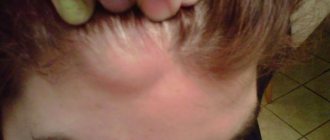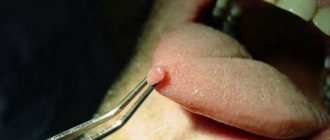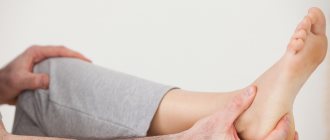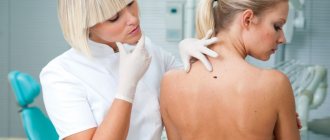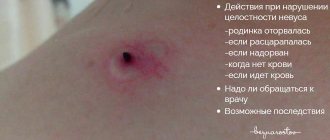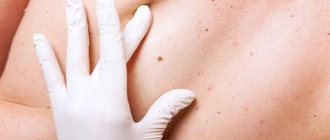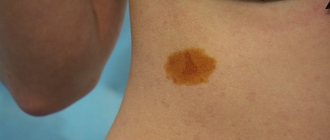Stages of mole healing
With proper care, the removal site heals completely in 3-4 weeks , the skin color becomes even, and no scars remain if all the rules for caring for the wound surface are followed at each stage.
Crust formation (0-7 days)
After the removal procedure, redness and slight swelling occur for several hours, which then subside. Then a dark crust forms at the site of the mole. It serves as a skin protector, helping to protect the wound from infection. Also, epithelial tissue grows very quickly under the crust.
Note! It is very important to avoid tearing off and damaging the crust, which can occur as a result of scratching with nails, rubbing with clothing, or a hard washcloth. If necessary, the removal site must be treated with special ointments.
Crust falling off (7-14 days)
Within 1-2 weeks after removal, the crust disappears, and new light pink skin remains in its place. It is important not to expose it to UV rays . To do this, use sunscreen with a high SPF level, avoid direct exposure to the sun and do not visit a solarium.
Smoothing of the pit from removal (after 20 days)
At the site of the removed mole, a skin is formed that can withstand mechanical stress. As a result, the pit is smoothed out, and the skin does not require further special care.
General restrictions after mole removal
- Hypothermia and overheating should . Limit visits to saunas and steam baths, do not douse yourself with cold water. Sudden changes in temperature can cause increased skin sensitivity. The limitation period is 2 weeks.
- Try to avoid rubbing the removal site with clothing. Choose things made from natural, thin fabrics that will not cause harm to the wound surface.
- If the nevus was on the face, then you should not use decorative cosmetics at the site of removal for 7-10 days after the procedure.
- Prolonged contact with water softens the skin and can lead to rejection of the epidermis in the area of removal. Therefore, do not go to the pool, take a bath for a short time in the first 2 weeks. Then your favorite water treatments can be resumed.
- Do not visit the solarium for a month to avoid the appearance of age spots.
- Use sunscreen . This will not only help avoid possible complications, but also protect your skin from premature aging.
- Avoid drinking alcohol for 3 days after the procedure. Alcohol-containing drinks cause blood vessels to dilate, which can lead to bleeding.
Brown moles
Such moles are a cluster of nevus cells. These cells are very similar to melanocytes and, like them, produce the pigment melanin. This pigment is brown in color, which makes our skin darker if there is a lot of it and lighter if there is not enough of it. Its production also increases after prolonged exposure to the sun.
Melanocytes and nevus cells
Melanocytes and nevus cells have certain differences, which we will not delve into. Let’s just note that brown moles most often consist of nevus cells. It is nevus cells that can turn into melanoma cells - one of the most malignant human tumors (more about it here)
Products for treating skin after destruction
Additional treatment is required if there are symptoms of infection or injury to the extraction site. The following medications are suitable for this:
- Actovegin is a drug that improves cellular regeneration. Promotes rapid wound healing and helps prevent infection.
- Baneocin is a topical antibiotic. Eliminates infection, accelerates wound healing.
- Solcoseryl - has a wound-healing, regenerating effect. Activates cellular metabolism and accelerates collagen synthesis.
Potassium permanganate solution for treating wounds
A solution of potassium permanganate has a disinfecting effect and prevents infection. It is important to dilute the solution correctly, because a high concentration of potassium permanganate can lead to a chemical burn to the skin. Therefore, you need to ensure that the color of the manganese solution has a slightly pinkish tint .
You can use the product from day 1 of removal.
Photo 2. It is important that the potassium permanganate solution is pale pink. Concentrated solution may cause burns. Source: Flickr (Sami-Marie)
Complications after removal
It is very important to ensure proper skin care after the removal procedure. With improper care, various complications are possible:
- Recurrence of formation (i.e. the mole forms in the same place);
- Introduction of infection into the body;
- Scars, cicatrices and age spots.
It is important! If pus comes out of the wound, swelling and redness do not go away for several days, or there is severe itching, be sure to consult a doctor!
To avoid the risk of complications, be responsible when choosing the removal method and your doctor. You should not remove formations in beauty salons; it is better to carry out the procedure in a medical clinic, making sure that all certificates are available.
Contraindications for removal
- exacerbation of chronic diseases;
- infectious diseases;
- dermatoses;
- the presence of open wounds, abrasions, and other pigment spots near the tumor;
- the mole is at the stage of transformation into melanoma.
Timely consultation with a doctor and correct diagnosis will help prevent the neoplasm from becoming malignant. If there is no effect as a result of using traditional methods, the doctor will suggest hardware procedures: radio wave method, cryodestruction, laser exposure, removal with high-frequency electric current.
Possible consequences
The consequences of complications can be very different. So, , malignancy of the skin occurs - the process of the formation becoming malignant. It is necessary to contact a specialist if, after the procedure, the formation appears again and begins to actively grow.
If the crust comes off, may become infected . Viral microorganisms enter the wound, which can cause a general infection or even blood poisoning. Symptoms of infection are fever, discharge of pus, and chills.
Removing moles using a laser is one of the safest ways to get rid of nevus. The entire procedure is carried out according to a clearly defined algorithm. You can avoid complications and unforeseen consequences if you follow the doctor’s recommendations for the next two weeks.
The danger of various types of tumors
Every person has wondered at least once in his life whether nevi are dangerous and whether birthmarks can be removed. They initially belong to benign formations and do not pose any danger to the body. However, under certain conditions, such a skin tumor can degenerate into a malignant cancer, which will require immediate removal of the affected tissue and subsequent appropriate treatment with chemotherapy or radiation.
It has been established that certain types of moles, which are localized on the mucous membranes and in the area of the female genital organs, often lead to cervical cancer, so most oncologists recommend removing them even before the degeneration of a benign tumor into a malignant one. Every person, regardless of the location of moles, needs to constantly examine them and if there is a change in color, bleeding or a sharp increase in size, immediately consult a doctor for a diagnosis.
When such age spots and moles are localized on the face, they are often removed for cosmetic reasons. For many girls and women, such neoplasms, when localized near the lips, in the area of the nose, eyes and on the forehead, cause a lot of psychological inconvenience.
In such a case, you should contact cosmetologists or specialized oncology centers, where, using modern equipment, after diagnostics, the doctor will determine whether it is possible to remove the birthmark on the face, solving the existing problems.
How does the healing process work?
- 3-4 hours after removal of the mole, the wound is covered with a dark dense crust. And after a few hours, the area around it swells and turns red. This is an absolutely normal reaction of the body. The entire healing process lasts from 14 days to a month.
- First week. The scab that appears at the site of the birthmark is prohibited from being torn off. It has a protective function: to protect the wound from infection and allow new tissue to grow. The wound is protected from mechanical damage, friction with clothing, a bath sponge, and scratching. You should also not use cosmetic creams.
How to care for a wound after mole removal
Sometimes the doctor prescribes treating the scab with disinfectants or ointment with an antimicrobial effect. The most popular care products after mole removal include:
- weak solution of potassium permanganate. It dries out the crust and has an antiseptic effect;
- alcohol solution of brilliant green, or brilliant green. Also a good antiseptic.
Otherwise, routine wound care after mole removal boils down to monitoring the damaged area. Signs of an incorrect healing process will be:
- purulent discharge;
- severe itching, wetness;
- prolonged bleeding;
- increased body temperature;
- noticeable swelling of the skin for several days.
If you notice these symptoms, contact your doctor.
What restrictions exist after the procedure?
- In the first three to five days after the procedure, alcohol is excluded from the diet. Alcoholic drinks dilate blood vessels, increasing the likelihood of bleeding.
- For two weeks after laser removal of a birthmark, you should avoid contact with water. It is recommended not to visit the bathhouse, sauna, or swimming pool.
- You will have to protect your skin from sunlight and solarium lamps for a whole month. This will save you from possible hyperpigmentation.
If you follow simple wound care rules after mole removal, recovery will be quick and painless.
Good afternoon. Today I’ll tell you how the recovery process goes after laser removal of moles and other tumors.
Pathological moles
There are other neoplasms that rightly cause concern in their owner. They can provoke the development of skin cancer. These moles also require removal, but this should be done by an oncologist or surgeon, with the selection of subsequent therapy. Removing pathological moles in aesthetic clinics and centers is extremely dangerous, which is why competent and conscientious plastic surgeons prescribe a series of tests at the slightest suspicion of a malignant growth.
The main signs of a “suspicious” mole:
• Abrupt appearance in adulthood;
• Intensive growth up to 1 cm in diameter;
• Rapid modification of form and structure;
• “Glossy” or rough surface, disappearance of the skin pattern from the elevation;
• Thinning texture;
• The appearance of pronounced asymmetry;
• Peeling of the surface followed by the formation of a crust;
• Presence of itching and burning in the area of the tumor;
• Partial or complete loss of hair from the surface;
• The appearance of depigmented areas, complete or partial change in color;
• Ulcerations on the surface;
• Formation of daughter nodules;
• The presence of hyperemia and swelling around the nevus;
• Formation of new nodules directly on the surface;
• Bleeding (sudden or with minor trauma);
• Separation of moisture and exudate.
How does the site of mole and papilloma removal heal?
The healing and recovery process after removal is individual. If the tumors are delicately removed, then the rehabilitation period is only If moles or core warts were removed, then the healing is longer. It takes longer to heal in the elderly, in people with chronic diseases, especially in diabetics and people with low hemoglobin.
Healing occurs with the formation of a scab, then the scab falls off and a scar forms. Normally, the scar does not extend beyond the removed element and is pushed to the level of the adjacent skin. Hypotrophic scars (with tissue retraction) can develop in two ways: if deep removal (moles) is necessary or if this is genetically determined. A hypertrophic scar may form - the connective tissue rises above the skin level, but does not extend beyond the removed lesion. This occurs when the removed element was in a place of friction with clothing, at the time of healing to form a scar.
The listed options for scar formation refer to the normal outcome of healing of remote formations. An atypical (non-characteristic) form of scar is keloid growth. The keloid scar extends above the surface of the skin and beyond the boundaries of the removed element, and it is burgundy, with a bluish tint and very dense. A correctly collected anamnesis helps to avoid such a complication: it is necessary to find out about heredity burdened by this factor; in women with pierced ears, this can be found out by palpating the earlobe.
What mole removal procedures exist in modern medicine?
After conducting a study of the formation, you need to choose exactly how to eliminate the nevus. At the moment, medicine provides the following methods for removing moles:
- surgical
removal of a mole; - removal of moles with nitrogen ( cryodestruction
); - removal of a mole by electrocoagulation
; - laser mole removal – laser therapy
; - radio wave excision
– getting rid of a tumor using high-frequency waves.
Let's take a closer look at the advantages and disadvantages of the above methods.
Surgical removal
It is one of the most reliable methods for removing skin tumors. The surgeon cuts off the mole with a scalpel at skin level or a little deeper and cauterizes the wound. An antibiotic and a bandage are then applied. Or the surgeon removes the mole and its surrounding area. The size of the area removed depends on the surgeon's opinion of the possibility of cancer developing. After cutting out a large area, stitches are placed. After some time, the doctor will remove the stitches on the surface of the skin.
Pros:
- if precise technology is followed, there is no likelihood of relapse;
- excision occurs with partial removal of the surrounding skin, which also prevents the risk of re-growth;
- it is possible to analyze the material remaining after removal for histology;
- reasonable price of the procedure;
- There are practically no contraindications.
Minuses:
- scar after mole removal;
- long period of healing and recovery.
Cryodestruction
This method is used mainly for small formations. Removal of moles of papillomas is also carried out using this method. This procedure is suitable for removing moles in visible places. Using an applicator, liquid nitrogen is applied to the neoplasm, causing it to thicken and turn white. Then a bubble appears at the cauterization site, which subsequently decreases and turns into a crust. Within 14 days, the crust falls off and pink skin remains in place of the mole.
Pros:
- 100% painless;
- no scars or scars remain on the skin;
- inexpensive;
- quick removal;
- minimal risk of infection.
Minuses:
- it is difficult to predict the area of distribution of liquid nitrogen and there is a possibility of damage to healthy tissues by cold;
- for the same reason (the unpredictability of the spread of liquid nitrogen), the nevus may not be completely removed, which means repeated removal will be required;
- the inability to conduct a histological examination of the removed material, which increases the risk of not finding out about melanoma or skin cancer in time.
The disadvantages of cryodestruction are quite significant, so before removal by this method, you should carefully weigh the pros and cons.
Removal with an electrocoagulator
Electrocoagulation successfully fights interfering moles, HPV, warts, complicated acne and many other ailments. When removing moles with an electrocoagulator, the doctor selects the power of the device, which, using a loop-tip, acts on the mole with an electric current. This method takes about 20 minutes, sometimes less, depending on the diameter of the nevus.
Pros:
- absence of blood and risk of infection;
- painlessness (local anesthetic is injected);
- the ability to submit the remaining material from removal for histological analysis;
- the ability to control the depth of removal of the epidermis and dermis.
Flaw:
- A crust forms at the removal site, which falls off in a week or less, but may leave a white spot (therefore, the procedure is not always suitable for particularly noticeable areas).
Laser therapy
Laser therapy is excellent for removing small tumors. Nowadays, laser therapy is recognized as the most popular and effective method for removing moles on the face. The essence of the procedure, like the surgical method, is to completely eliminate the mole. In order to remove a mole without damaging the surrounding skin, a beam with a certain wavelength is selected. The action of the beam is aimed exclusively at the melanin contained in moles and birthmarks.
Advantages:
- painlessness of the procedure;
- no chance of relapse;
- high precision of beam direction, helping to avoid damage to adjacent areas of the skin;
- the operation lasts several minutes;
- due to cell stimulation with laser, healing occurs in the shortest possible time;
- the ability to eliminate several nevi in one session;
- no bleeding;
- no special care required after surgery;
- a short rehabilitation period, during which you can play sports and swim, you just need to avoid direct sunlight on the operated area.
Flaw:
- inability to send removed material for histological examination. Therefore, the decision to remove a mole with a laser is made only when it is confirmed that the mole is non-cancerous.
Radio wave excision
It is carried out using a special device that reproduces high-frequency radio waves. With its help, you can remove formations of any size and in any quantity. This method includes the same advantages as laser therapy, but in addition allows you to take material for histological examination. It can rightfully be recognized as the safest and most effective way to remove moles in modern medicine.
Recovery after tumor removal
The recovery process after removal of tumors can be different and depend on many factors:
- The type of formation on which the depth of removal depends (for example, a mole is removed quite deeply, and a pedunculated papilloma is removed very superficially);
- Size of the removed tumor;
- The patient’s age (the older a person gets, the more regeneration processes slow down);
- Localization of neoplasms: in areas of friction with clothing, recovery takes a longer time, and in open areas, moles and papillomas heal much faster;
- Concomitant diseases slow down recovery;
- Correctly following your doctor’s recommendations for home care.
From all of the above, we can summarize that the recovery process is purely individual.
How is diagnosis done?
To make an accurate diagnosis, a mole doctor uses the following methods:
- Biopsy. This diagnostic method is used if there is a suspicion that the formation is malignant. Using forceps, a small part is torn off from the nevus. The separated piece is placed in a special container and sent for thorough examination in the laboratory.
- Dermatoscopy. This diagnostic method uses a dermatoscope. First of all, the doctor smears the birthmark with the necessary solution. Then he examines the nevus with a dermatoscope.
- Computer diagnostics. This method involves examining the formation using a digital video camera, which is equipped with good resolution. With a thorough examination of the disturbing spot, the doctor is able to determine what changes are occurring in the nevus.
- Histology. This method consists of taking a sample of mole tissue and transporting it to a laboratory where it will be tested for the presence of cancer cells.
First, the doctor will find out how long ago the changes in the formation have been occurring, then examine the place where the inflammatory process is occurring, and then prescribe an additional examination, which consists of a general blood test and an analysis for the presence of the papilloma virus. The doctor will make a diagnosis after receiving the results of all tests. Based on the diagnosis, you can choose an effective and safe method of treating the birthmark.
Which doctor should I show a child's mole to?
If a small child has a mole on his body that is growing, the therapist will tell you which doctor to go to. Such a doctor is universal. After personally examining the growth in the child, he will determine which specialist to next refer the patient to. Often a referral is made to a pediatric dermatologist.
When visiting a dermatologist, the child will be examined again, a dermatoscopy procedure will be performed, on the basis of which a decision will be made whether the formation in a small child needs to be removed, or whether it can be left alone and drug treatment can be resorted to. Checking with a dermatoscope is a painless procedure. The advantage of this diagnostic method is the identification of early stages of cancer that can be treated.
If examination with a dermatoscope shows that the formation is malignant and should be removed, the pediatric dermatologist will explain the name of the doctor for moles that need to be removed. The surgeon will be able to study the results of the analysis and suggest removing the child’s mole in a more effective and safe way. After choosing an acceptable method, the child will undergo a procedure to remove the nevus.
Creams after laser removal of papilloma or mole
After removal, it is necessary to treat the wounds 2 times a day. To do this, use a dark solution of potassium permanganate (potassium permanganate) or a ready-made pharmaceutical solution “Fukortsin”. Then sprinkle the surface with Baneocin antibacterial powder. On top, to speed up regeneration and prevent severe scarring, apply Bepanten, Emalan cream, methyluracil ointment or Solcoseryl.
The removal site should not be wet and should be covered with adhesive tape. You can't peel off the crust. If suddenly the removal site gets wet, then use an alcohol solution, for example, calendula tincture to dry it. If the removal was carried out on the face, then after the crust has come off, lubricate the area and the entire face with sunscreen: in the cold season with SPF factor and during solar activity with SPF 50.
Author of the article: cosmetologist G. V. Stepanenko
Comments
- megan92 () 2 weeks ago
Has anyone managed to get rid of papillomas in their armpits? They really bother me, especially when you sweat.
- Daria () 2 weeks ago
I have already tried so many things and only after reading this article, I was able to get rid of papillomas in the armpits (and on a very budget). PS But I’m from the city myself and didn’t find it on sale here, so I ordered it online.
- megan92 () 13 days ago
Daria, post a link to the article! PS I'm from the city too))
- Daria () 12 days ago
megan92, that’s what I wrote in my first comment) I’ll duplicate it just in case - a link to the article.
- Sonya 10 days ago
Isn't this a scam? Why do they sell on the Internet?
- Yulek26 (Tver) 10 days ago
Sonya, what country do you live in? They sell it on the Internet because stores and pharmacies charge outrageous markups. In addition, payment is only after receipt, that is, they first looked, checked and only then paid. And now everything is sold on the Internet - from clothes to TVs and furniture.
- Editor's response 10 days ago
Sonya, hello. This drug for the treatment of papillomavirus infection is indeed not sold through pharmacy chains and retail stores in order to avoid inflated prices. As of today, you can only order on the official website. Be healthy!
- Sonya 10 days ago
I apologize, I didn’t notice the information about cash on delivery at first. Then everything is fine if payment is made upon receipt.
- Margo (Ulyanovsk) 8 days ago
Has anyone tried traditional methods to get rid of warts and papillomas?
- Andrey A week ago
I tried to burn off a wart on my head with vinegar. The wart really went away, only in its place there was such a burn that my finger hurt for another month. And the most annoying thing is that after a month and a half, two more warts popped up nearby ((
- Ekaterina A week ago
I tried to burn out the papilloma with celandine, but it didn’t help, it just turned black and became so scary (((
- Maria 5 days ago
I recently watched a program on Channel One, they also talked about this PAPIFEX. Many doctors recommended for treatment. I ordered it, I use it, and indeed, the papillomas are dissolving one by one, there are only 2 left, the most tenacious ones.
- Elena (dermatologist) 6 days ago
Maria, soon these two will disappear too!
- Alexandra (Syktyvkar) 5 days ago
A good product, completely worth the price. I have never seen any analogues.
- Maxim Today
Has anyone tried to reduce papillomas with liquid nitrogen?
- Tatyana (Ekaterinburg) Today
Yeah, you burn one, after a month three more grow ((I don’t recommend liquid nitrogen, although hospitals often use it
- Elena (dermatologist) 6 days ago
Tatyana, liquid nitrogen is a thing of the past, now PAPIFEX is used in full and there is no need to go to the doctors!
- Mikhail (Moscow) Today
PAPIFEX also helped (I ordered it according to the advice above), it should work, try it
- Vika (Ekaterinburg) Today
That's great! I need to order, otherwise I’m already tormented with these warts! After all, a woman always wants to be beautiful!
- Kristina (Minsk) Today
I had papillomas removed with a laser, quickly and without pain. But it's damn expensive.
Which methods do NOT allow for histological examination?
There is only one such method - removal with liquid nitrogen.
Unfortunately, a jet of this substance cannot be used as a cutting instrument and the mole cannot be preserved for histological examination.
This is why I, as an oncologist, do not recommend removing moles with liquid nitrogen,
because... lack of histological examination may make removal dangerous.
Destruction of a mole during removal is dangerous.
In addition, electrocoagulation, laser and radio wave surgery
when used as methods of destruction (synonyms - resolution, evaporation, burning) may also
not leave
behind material for histological examination.


